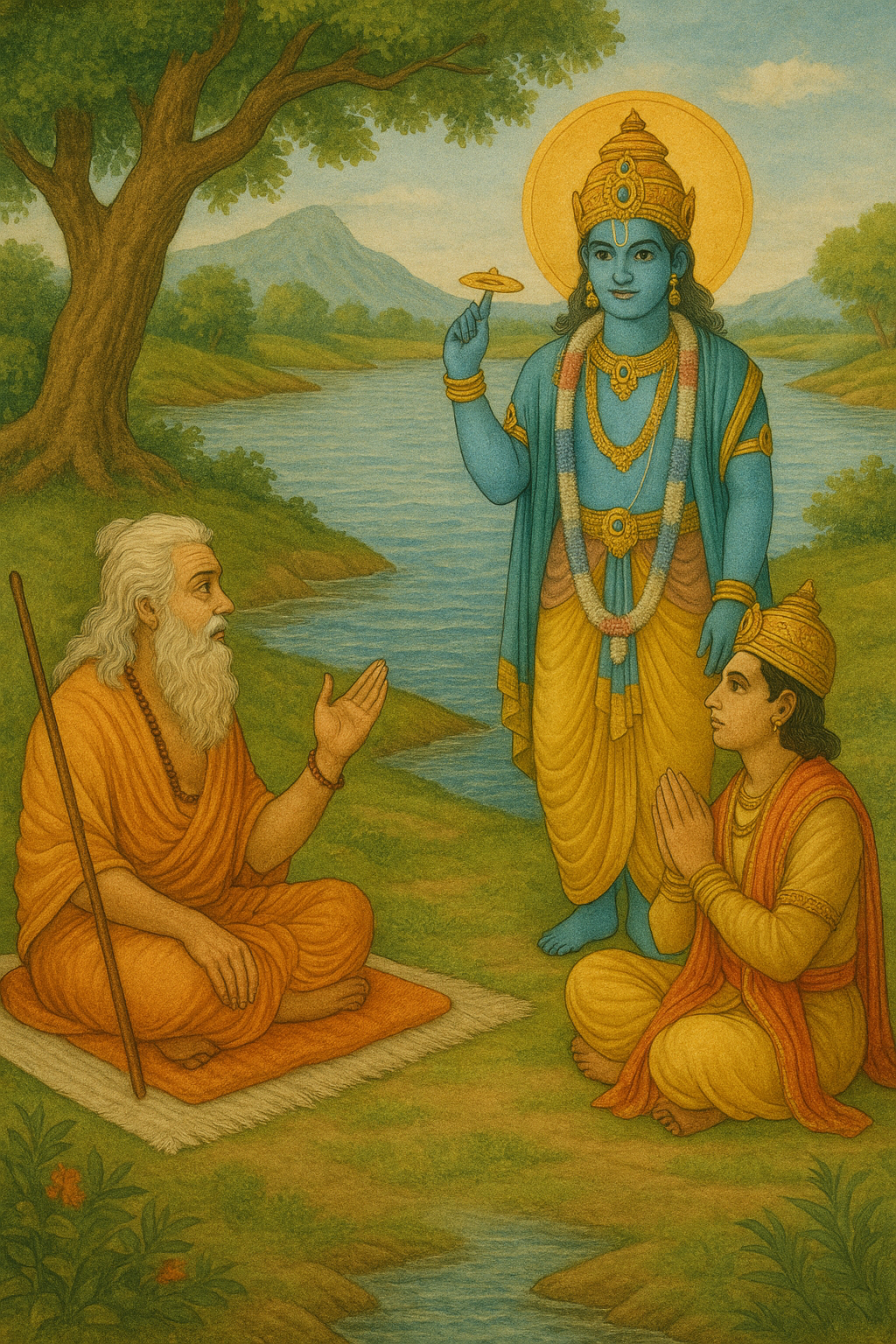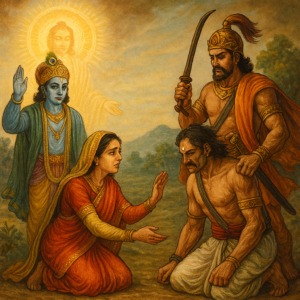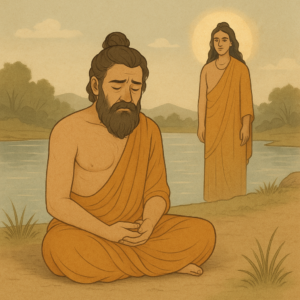Much like today’s hustle for answers, King Parikshit, grappling with existential questions, sought wisdom from sage Shree Shukdevji. What followed was a profound recounting of divine avatars—timeless narratives revealing secrets to overcoming chaos, finding balance, and fostering righteousness.
From restoring balance like Varaha to teaching perseverance like Dhruva, these ancient tales resonate with the challenges of modern living. Curious to uncover their relevance today? Dive in to explore how these timeless lessons empower us to navigate the turbulence of life with unwavering faith and purpose.
In a moment of deep curiosity, King Parikshit approached the revered sage Shree Shukdevji, asking him to expound on the qualities of the Supreme Divine. Shree Shukdevji, immersed in remembrance of Lord Krishna, began to recount an eternal dialogue first shared between the celestial sage Narada and his father, Brahmaji.
Narada Muniji, inspired by compassion for all living beings, had once inquired of Brahmaji, “What is the nature of the soul and the cosmos? Who governs it? And on what foundation does this vast creation rest?” Brahmaji, acknowledging the profundity of the questions, attributed the creation, sustenance, and destruction of the universe to the will of Lord Narayan. He explained that even his own powers as the creator of the cosmos were bestowed by Narayan, the Supreme Being, who is beyond Maya (illusion) and encompasses infinite qualities.
Shree Shukdevji began his teachings with a revelation: all avatars of Lord Narayan manifest for specific purposes, embodying divine qualities to guide humanity and reestablish righteousness.
The Divine Manifestations of Vishnu
1. The Varaha: The Savior of Earth – In an age when the Earth was submerged in the cosmic ocean, Lord Vishnu took the form of Varaha, a giant boar, to lift it out of the waters. This act of salvation was a reminder of the divine’s power to restore balance, even in the face of apocalyptic despair.
2. The Incarnation of Suyagya – Born to Prajapati Ruchi and his wife Akuti, Lord Vishnu appeared as Suyagya. Marrying Dakshina, He blessed the world with the Suyam Devtas, who alleviated the tribulations of the three realms. This avatar established the importance of righteousness and partnership in the service of humanity.
3. Kapila: The Enlightened Teacher – As Kapila, born to Devhuti and Kardama Prajapati, Lord Vishnu imparted Sankhya philosophy, guiding seekers toward self-realization. Through this incarnation, He demonstrated that enlightenment can be attained in a single lifetime through unwavering devotion and wisdom.
4. Dattatreya: Embodiment of Grace – To fulfill sage Atri’s wish, Vishnu manifested as Dattatreya, a revered teacher whose lotus feet granted spiritual liberation to kings like Yadu and Sahastrarjuna. His life symbolized selfless giving and the boundless grace of divinity.
5. The Four Kumaras: Eternal Seekers – In the cosmic dawn, Brahma’s austerities pleased Vishnu, who manifested as the Kumaras—Sanaka, Sanandana, Sanatana, and Sanatkumara. They rekindled self-knowledge among sages, exemplifying the timeless pursuit of spiritual wisdom.
6. Nar and Narayan: Guardians of Dharma – Born to Murti and Dharma, Vishnu’s dual forms embodied penance and righteousness. Through unwavering austerities, they set a precedent for inner discipline as the path to self-realization.
7. Dhruva: The Immovable Devotee – Manifesting through unwavering faith, Vishnu ensured the elevation of Dhruva to an eternal celestial position. His story teaches perseverance and dedication, showing how even a child’s devotion can reach the divine.
8. Prithu: The Earth’s Protector – As Prithu, the Earth’s first crowned king, Vishnu ensured the prosperity of all beings by making the Earth a symbolic cow and milking its resources. He demonstrated the role of stewardship and the importance of just governance.
9. Rishabhadeva: The Paramhansa – Born to King Nabhi and Sudevi, Rishabhadeva exemplified detachment and asceticism. Renouncing worldly ties, He embodied the ultimate state of realization known as Paramhansa.
10. Hayagriva: The Keeper of Knowledge – Emerging as Hayagriva, Vishnu restored the lost Vedic knowledge during cosmic upheaval. This avatar symbolizes the eternal preservation of wisdom amidst chaos.
11. Matsya: The Great Fish – In the guise of a fish, Vishnu guided Manu, the progenitor of humanity, and safeguarded the Vedas during the great flood. This incarnation highlighted His role as the eternal preserver of life and knowledge.
12. Kurma: The Tortoise – During the churning of the ocean for nectar, Vishnu appeared as a tortoise to support Mount Mandarachal. This act emphasized the divine’s willingness to bear the burden for the greater good.
13. Narasimha: The Protector of Devotion – Assuming the fierce form of Narasimha, half-man and half-lion, Vishnu vanquished Hiranyakashipu to protect His devotee, Prahlada. This avatar illustrated the boundless power of faith.
14. Lord Chakrapani: the Rescuer – A crocodile once caught Gajendra, an elephant, by the leg, leaving him in great distress. Calling out to the Supreme Lord for help, Gajendra’s plea reached the Lord Chakrapani. The all-powerful Lord, riding on Garuda, swiftly arrived and used his divine chakra to sever the crocodile’s head, rescuing his devotee.
15. Vamana: The Dwarf King – As the diminutive Vamana, Lord Vishnu humbled the mighty King Bali. Measuring the universe with three steps, He demonstrated the supremacy of righteousness over power.
16. Dhanvantari: The Healer – Emerging with the nectar of immortality, Dhanvantari alleviated physical suffering. This avatar reflects the eternal commitment of divinity to healing and restoration.
17. Parashurama: The Warrior Sage To rid the Earth of oppressive rulers, Vishnu incarnated as Parashurama and wielded His axe to restore balance. This form underscores the importance of using power responsibly to uphold dharma.
18. Rama: The Embodiment of Virtue – In the lineage of the Sun, Vishnu’s incarnation as Lord Rama showcased ideal kingship, unwavering virtue, and devotion to duty. His journey teaches resilience, love, and the triumph of good over evil.
19. Krishna and Balarama: The Supreme Mystics – As Krishna and Balarama, Lord Vishnu’s divine plays enchanted the world and illustrated spiritual truths. Krishna’s Lilas and granting liberation to demons, epitomize the infinite love and power of the divine.
20. Kalki: The Future Redeemer – At the close of Kali Yuga, Vishnu will incarnate as Kalki, the harbinger of dharma’s restoration. His arrival will herald a new age of righteousness, ensuring the eternal cycle of creation, preservation, and destruction continues.
Through these tales, Shree Shukdevji emphasized that every incarnation is a beacon of divine wisdom, compassion, and justice, showing humanity the path to transcendence.
Profound Lessons
Brahmaji explained that the universe and its cycles—creation, preservation, and dissolution—are governed by the Supreme. Beyond the visible cosmos, the Lord is infinite, eternal, and beyond the reach of the three gunas (qualities of nature—sattva, rajas, tamas). Meditation, devotion, and surrender are the keys to understanding this divine essence.
He recounted the miraculous and virtuous deeds of Krishna, illustrating how even the divine plays a role in the lives of ordinary beings, serving as a constant refuge. From guiding King Bali to humbling Indra, the Lord’s actions demonstrate the eternal truth: those who live by dharma will always find protection and liberation.
Closing Thought
The avatars of Lord Narayan are not just mythological tales—they are blueprints for living. The world may change, but the eternal truths they reveal remain relevant. They remind us that righteousness, humility, and devotion are our anchors, no matter the challenges.
The miracles of Lord Krishna reflect how faith and surrender can lead us through life’s storms, just as He protected His devotees in their darkest hours. Today, practices such as mindfulness, yoga, and devotional chanting mirror ancient methods of connecting with the divine and cultivating peace amidst chaos.
As we move through the trials of modern existence, these divine narratives inspire us to see the sacred in all things. To align with their essence is to find meaning and liberation in every moment. Let us, like Parikshit, seek the divine wisdom hidden within our own hearts, for it is there that the Supreme truly resides.



